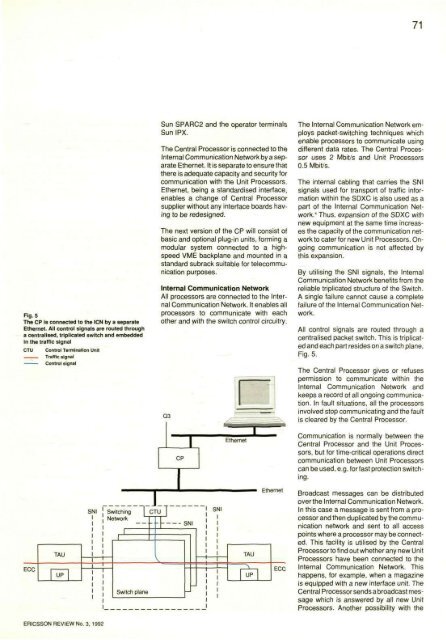An Introduction to the Ericsson Transport Network Architecture ...
An Introduction to the Ericsson Transport Network Architecture ...
An Introduction to the Ericsson Transport Network Architecture ...
You also want an ePaper? Increase the reach of your titles
YUMPU automatically turns print PDFs into web optimized ePapers that Google loves.
71<br />
Fig. 5<br />
The CP is connected <strong>to</strong> <strong>the</strong> ICN by a separate<br />
E<strong>the</strong>rnet. All control signals are routed through<br />
a centralised, triplicated switch and embedded<br />
in <strong>the</strong> traffic signal<br />
CTU<br />
I<br />
Control Termination Unit<br />
Traffic signal<br />
Control signal<br />
Sun SPARC2 and <strong>the</strong> opera<strong>to</strong>r terminals<br />
Sun IPX.<br />
The Central Processor is connected <strong>to</strong> <strong>the</strong><br />
Internal Communication <strong>Network</strong> by a separate<br />
E<strong>the</strong>rnet. It is separate <strong>to</strong> ensure that<br />
<strong>the</strong>re is adequate capacity and security for<br />
communication with <strong>the</strong> Unit Processors.<br />
E<strong>the</strong>rnet, being a standardised interface,<br />
enables a change of Central Processor<br />
supplier without any interface boards having<br />
<strong>to</strong> be redesigned.<br />
The next version of <strong>the</strong> CP will consist of<br />
basic and optional plug-in units, forming a<br />
modular system connected <strong>to</strong> a highspeed<br />
VME backplane and mounted in a<br />
standard subrack suitable for telecommunication<br />
purposes.<br />
Internal Communication <strong>Network</strong><br />
All processors are connected <strong>to</strong> <strong>the</strong> Internal<br />
Communication <strong>Network</strong>. It enables all<br />
processors <strong>to</strong> communicate with each<br />
o<strong>the</strong>r and with <strong>the</strong> switch control circuitry.<br />
The Internal Communication <strong>Network</strong> employs<br />
packet-switching techniques which<br />
enable processors <strong>to</strong> communicate using<br />
different data rates. The Central Processor<br />
uses 2 Mbit/s and Unit Processors<br />
0.5 Mbit/s.<br />
The internal cabling that carries <strong>the</strong> SNI<br />
signals used for transport of traffic information<br />
within <strong>the</strong> SDXC is also used as a<br />
part of <strong>the</strong> Internal Communication <strong>Network</strong>."<br />
Thus, expansion of <strong>the</strong> SDXC with<br />
new equipment at <strong>the</strong> same time increases<br />
<strong>the</strong> capacity of <strong>the</strong> communication network<br />
<strong>to</strong> cater for new Unit Processors. Ongoing<br />
communication is not affected by<br />
this expansion.<br />
By utilising <strong>the</strong> SNI signals, <strong>the</strong> Internal<br />
Communication <strong>Network</strong> benefits from <strong>the</strong><br />
reliable triplicated structure of <strong>the</strong> Switch.<br />
A single failure cannot cause a complete<br />
failure of <strong>the</strong> Internal Communication <strong>Network</strong>.<br />
All control signals are routed through a<br />
centralised packet switch. This is triplicated<br />
and each part resides on a switch plane,<br />
Fig. 5.<br />
The Central Processor gives or refuses<br />
permission <strong>to</strong> communicate within <strong>the</strong><br />
Internal Communication <strong>Network</strong> and<br />
keeps a record of all ongoing communication.<br />
In fault situations, all <strong>the</strong> processors<br />
involved s<strong>to</strong>p communicating and <strong>the</strong> fault<br />
is cleared by <strong>the</strong> Central Processor.<br />
Communication is normally between <strong>the</strong><br />
Central Processor and <strong>the</strong> Unit Processors,<br />
but for time-critical operations direct<br />
communication between Unit Processors<br />
can be used, e.g. for fast protection switching.<br />
Broadcast messages can be distributed<br />
over <strong>the</strong> Internal Communication <strong>Network</strong>.<br />
In this case a message is sent from a processor<br />
and <strong>the</strong>n duplicated by <strong>the</strong> communication<br />
network and sent <strong>to</strong> all access<br />
points where a processor may be connected.<br />
This facility is utilised by <strong>the</strong> Central<br />
Processor <strong>to</strong> find out whe<strong>the</strong>r any new Unit<br />
Processors have been connected <strong>to</strong> <strong>the</strong><br />
Internal Communication <strong>Network</strong>. This<br />
happens, for example, when a magazine<br />
is equipped with a new interface unit. The<br />
Central Processor sends a broadcast message<br />
which is answered by all new Unit<br />
Processors. <strong>An</strong>o<strong>the</strong>r possibility with <strong>the</strong><br />
ERICSSON REVIEW No. 3, 1992
















